I love whitework embroidery. I love monograms. I love drawn thread embroidery. I love linen! I love vintage linens! And I really love it when whitework and monograms and drawn thread are combined on one vintage embroidered linen! That’s what I call a winning combination! And oh, what a piece of embroidery this is!
Come gaze with me!
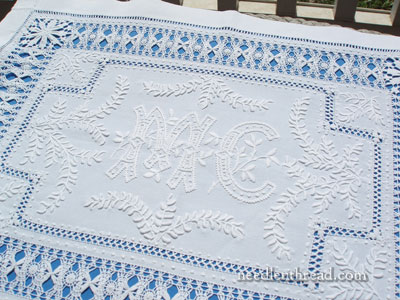
This is a gorgeous piece of vintage linen – an exquisite example or whitework at its best!
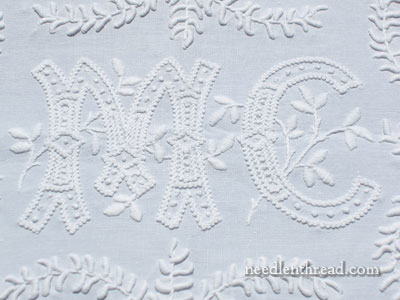
And no, I’m not just saying that because the monogram is “MC”!
Can you imagine my delight when I opened the mailbox on Saturday and found a package addressed to me, and within the package, this beauty? A reader wanted it to have an appreciative home – and she thought of me. Thank you, Sandra! I have Great Plans for It!
Let’s look at it more closely, shall we? After all, this is the type of beauty that needs to be shared!
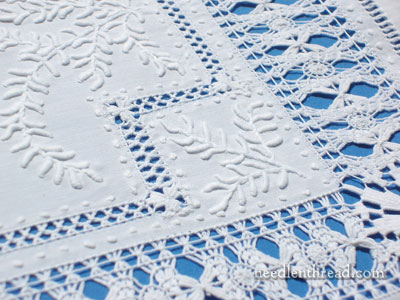
The piece is the size of a placemat. It is heavily embroidered with bullion stitched branches, and elaborately worked with drawn thread embroidery along the outer edge. The inside is set off with more drawn thread, and the initials are embroidered in wonderfully textured stitches.
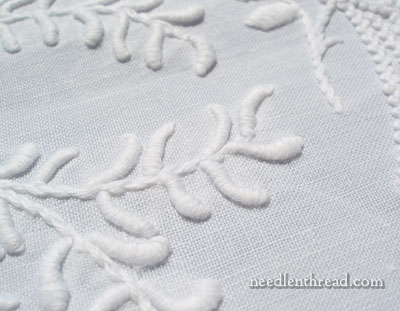
A close-up of the bullion stitched branches that adorn the linen.
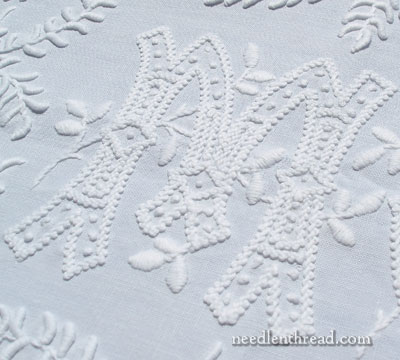
The M and the C are outlined in cable plait stitch and further embellished with petals worked in stem stitch. French knots dot the interior of the letters.
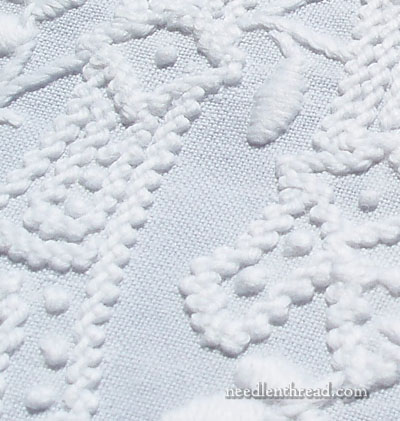
Here, you can see the cable plait stitch (or braid stitch) up close. The linen has been ironed, so the stitches are a little flattened. At first, I thought this was actually Palestrina stitch, flattened and broadened – but Yvette Stanton convinced me to look more closely at it, as it looked to her like cable plait stitch.
So I took up some needle and thread and followed the course of the stitches, imitating the outline here, and indeed, it is cable plait stitch.
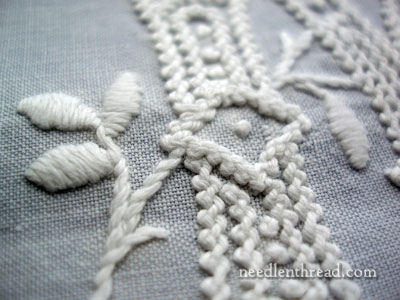
Applying a filter to the photo, you can see the stitching very clearly here. Thick, sumptuous, textured, lovely stitches! I feel as if they’re calling my name!
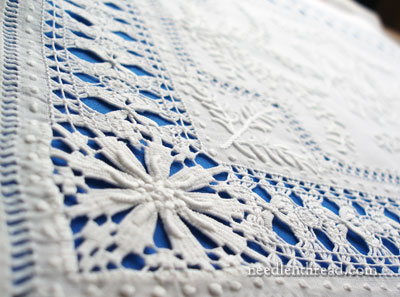
And oh, that drawn thread border! Can you just imagine the time it took to work this piece? The intricacy of the edge is something to behold!
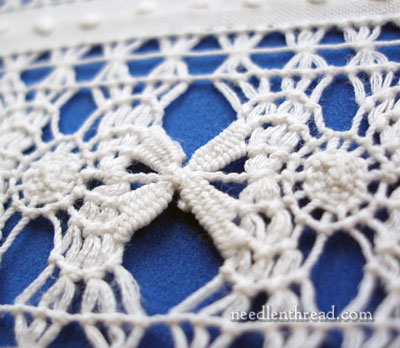
The needle lace bars, wraps and circles hold together the remaining linen threads securely, while at the same time decorating the piece in a deep, lacy trim.
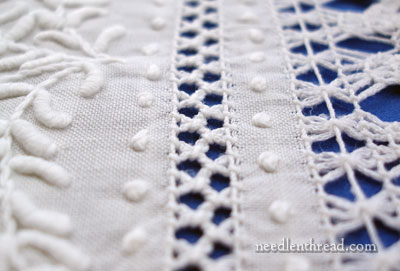
Between the sections of drawn thread, French knots march along in orderly, evenly spaced lines.
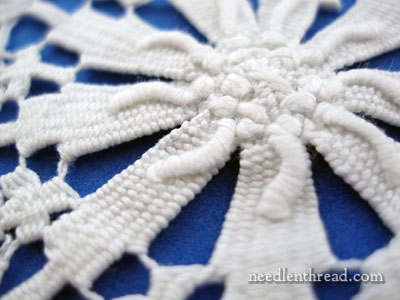
The needle lace on the corners is further adorned with French knots and bullion knots. Amazing detail!
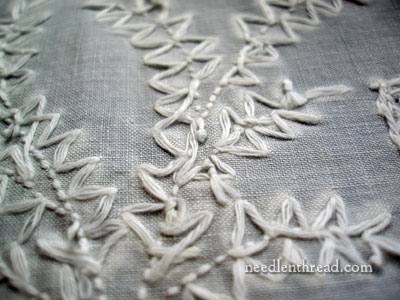
And for those who might be tempted to think that the bullions that pepper the piece might be satin stitch rather than bullion knots, just look at the back! You can see the starts and ends of all the stitches zig-zagging along the design lines.
Now… what would you do with this beautiful linen? Would you place it on a table or dresser, which is probably what it was originally intended for? Or tuck it away for safekeeping? My Mom came up with this idea: have it professionally mounted on a colored board and framed behind glass, and then hang it in my workspace, where it can continuously provide inspiration. And you know what? My mind is recalling that life-long lesson: Your mother is always right! In this case, I believe she is! I’ve never framed a vintage piece of whitework like this – one that is obviously intended to lie on a table top. But I think it will definitely be worth doing, don’t you?
Have you ever framed a piece of vintage linen like this? Any suggestions? Any other ideas for what to do with the piece, so that I can actually see it and appreciate it all the time? Share your thoughts!
Thank you again, Sandra! You’ve surely made this needlework nut happy!







Definately frame it!
Dear Mary, this is a masterpiece by Sandra, she surely has chosen a good home for it! I can just imagine the hours of work that went into it. Your mother is right, this piece should be mounted and framed and hanged where you can see it’s beauty constantly. This is ART. 🙂 Elza, Cape Town xxx
I framed an exquisite jacket that my mom made for me when I was a baby. I didn’t want to lose any of the work, both the front and back and so I floated it between 2 pieces of glass. I love it!
Mary: My thought was to frame it even before I continued reading your commentary and your mother’s suggestion. Great minds DO think alike! My addition to her suggestion is to frame it in floating glass so you can take it off the wall and show the wonderful backside of the piece – either in person or for future tutorials.
Thank you for sharing such a magnificient piece.
Bonnee
Floating glass is a good idea, Bonnee …. though I suppose it would have to go on a darkish wall! I’ll definitely consider this option – it would be nice to have “access” to the back of the piece! ~MC
Easy answer, Mary…put a nice dark piece of matboard on the back of the frame so it can be seen behind the white…and have just a couple of bent pins holding it there so all that you need do to see the back is just move the pins and remove the board. Since the piece would be still sandwiched between the sheets of glass, safe and easy. 🙂
What a treasure to have received this lovely piece. Sandra found the perfect home, where the needlework will be appreciated. Thank you for sharing the stitching with us. When I first saw the monogram, I wondered what stitch was used. Truly a work of art, from the heart. We can appreciate the time and talent that went into creating such a fine example.
I have framed several pieces of needlework. I have 2 that are lace and are mounted on a colored mat board. Enjoy your treasure!
Deb
Instead of framing why not place the piece under glass on a tray table or dreser top. This way you are able to enjoy it AND are also able to examine the back for future reference for classes, etc.
Dear Mary,
What a fabulous piece, you are blessed!
I think your mother’s idea is excellent! Another idea: in my grandmother’s time, it was common to put such pieces of work in a tray between the wood and the glass. These trays were used to serve tea or moka.
If you’re a tea lover, it’s nice a way to use this beauty.
Have a nice day!
The tray is a great idea, Mirabilys! I hadn’t thought of it, but I see a bunch of you are coming up with the same thought! ~MC
You’d have to seal it somehow…if you spilled anything…*shudder*
Mary, when you said, ‘put it on a tabletop or..’, my immediate reaction was horror and ‘NO! Frame that sucker!’
And so it shall come to be, I am sure.
Royal blue velvet over cork, careful use of extremely fine mounting pins…you might talk to the Victoria & Albert Museum (just as a fer-instance) to see how they would mount something similar for viewing in a frame….
Exquisite is the LEAST of the adjectives suitable to this piece….kudos to the reader who sent it your way!
LOL! Funny, Pam!
Can’t wait to see what your readers suggest. I have a piece of tat work from my mother – in – law that she did almost eighty years ago. She also wanted someone to have it that appreciated the had work put into it. If you do have it framed, please lets us know how you did it and a picture of it. You are a very lucky person to have recieved such a special gift.
Oh, yes, I’ll definitely let you know, Terri! ~MC
What a great piece of whitework, and a great job showcasing it for your blog. Here is an option in framing your piece. I found a piece of needlework my grandmother did. It lay framed in a wooden tray with brass handles and was covered with glass. Perhaps she used it as a tray on her table–so it served the original purpose but was protected. Or maybe, like me, she hung it on the wall and just admired it. Perhaps you could adapt her idea–and have two ways to appreciate your whitework.
That’s a good idea, Ruth – didn’t think of a tray! ~MC
Definitely frame it! I would make sure that the glass doesn’t touch the piece though so you can maintain as much of the depth of the piece as possible. I think there’s something called “museum framing” that is done in that format.
In any case, it is beautiful and it is a gorgeous example of one stitcher’s energy being passed along to another stitcher to be honored. What more could someone want?
Sandra knew what she was doing with this gift. What a wonderful thing to do!
Sue
G’day there Mary,
This is exciting. Good on you Sandra!
Before I read your Mum’s suggestion, I thought, this is one piece that must be framed behind glass.
I would keep it simple, but otherwise can only suggest you go by your instinct with the matt and frame. You’ll know when it’s right for you and your really precious “MC”. Take your time and perhaps even take photos of the matt/frame combinations that initially appeal and casually look them over away from distractions or pressures at the framers, seeing if one will jump out at you. I’ve not thought of taking photos before, but I suppose the framer wouldn’t mind. Just a thought anyway.
Also the photo programs (I use picasa on a Mac) often have framing/border options and I often ‘frame’ my photos. Is an endless selection of colours. The ‘framing’ is very simple, like museum style, but is good for colour ideas of both matt and frame against the photo of artwork, items, or general photography. I can use ‘border’ and ‘museum frame’, one after the other to get double or triple matts.
I can’t help out at all on mounting solutions though Mary.
Good Luck and am anticipating an interesting post later on the what and why fors results.
Cheers, Kath.
When you have this piece framed, mount it on museum or archival mat board. Have a spacer put in between the piece and glass. Use clear glass as opposed to non-glare (frosted look). The non-glare glass when spaced from the piece tends to make the details of the piece appear fuzzy. Beautiful whitework!
Hi Mary, that is one beautiful piece of embroidery! I keep looking at the “palestrina stitch” and wondering if it could be braid stitch/cable plait stitch. It looks very much like something you’d find on Mountmellick embroidery, and not just because it is white and chunky. I too love Palestrina stitch, but from what I can see in the photos, I’m just not sure it is. I’m happy for you to tell me I’m wrong though! 🙂
Yvette Stanton
You could be right, Yvette. Braid stitch didn’t even occur to me. Following the path of the thread in the stitches, it seemed to work out as a “squished” Palestrina stitch, kind of stretched off to the left. Or a knotted pearl stitch. It doesn’t quite seem to have the whole “pretzel” of the braid stitch, but I’ll take a closer look at it and see if I can trace out the thread path and recreate the stitch movement. ~MC
My mother-in-law collected vintage lace. She used dark, jewel-tone velvets as background, and it really showed all the airiness and spaces of the lace. Something similar would be lovely for this piece.
Gorgeous. What a find for your reader, what a gift for you. Are you sure she didn’t make that for you? I definitely would want to provide a way to preserve it, however, I would think that taking it out of the mount or frame might be something to do in the future. so, how to do both? We have glass tops on our dressers and table tops to help prevent scratches in the wood. I wonder if something along that line would work for this. There are spacers to put between the wood and the glass to raise the glass up. Then, maybe you can swap out your Rooster in the tray and use this piece for a change of pace? Or use different tray if the pieces are not the same size. Don’t know, just thoughts…
Beautiful piece of Whitework. What a great idea to frame it behind glass and keep in your sewing room, then you will see it all time. When you put things away you tend to forget them and this is too lovely to put away.
Framing it will keep the dust out of it and give you a chance to enjoy it. You could also applique it to a piece of dark fabric and then make a wall hanging out of the quilt block by layering a thin batting and backing it with another piece of linen or cotton. I would probably applique it to a backing fabric and then turn it into a lovely appliqued pillow for my living room. It is just the right size to do almost anything. What a lovely gift. Debbie
So many factors in framing it, avoiding any acid in the background contrast fabric or glass!
Contact the Lowell Textile museum in Massachusettes.
They actually have “textile scientist ” who preserve early American clothing.
They can give you advise.
Your wonderful embroidery piece is not about enjoying it now,
but having future generations enjoy it .
I have enjoyed looking at the pictures of this amazing piece of embroidery.
Thank you.
How Beautiful!!!! In my house, with grandchildren visiting, I would want it behind glass and think your Mom’s idea is wonderful. Another great idea that might work is sealed within a glass topped tea tray. Whatever you decide, place it where you can best enjoy it, and the time, talent and love involved in it’s creation.
I think framing would be great but I think a “course” to teach the signifcant parts for this would be better. Do you know anything about the “genealogy” of this piece? It is so important that we keep the old techiques and decorative stitches alive in today’s needlework. I know that this is your forte so I hope you will do more with this than just hang it on the wall.
Hi Mary,
What an exquisite gift! Sandra certainly did know that you would give it a very good home. 😉
You’ve gotten some good advice on framing it so far. As a professional framer I have a couple suggestions:
The “between two pieces of glass” so you can see both sides” could work IF it is carefully mounted, suspended in the openings of mats placed back to back, with the linen between them. The very edges of the linen would be sandwiched between the mats. This is a bit tricky to explain – but the idea is to make sure that there is ‘airspace’ around the linen and that it is not touching the glass. This type of framing would allow you to see both sides, keep the glass from pressing the stitching flat, and allow the fabric to ‘breathe’ so you don’t have concerns about there ever being condensation absorbed into the linen. But this does not offer the best support for the stitched piece.
To frame it more conventionally, with a colored board behind it so that the open work is highlighted, you can consider choosing a colored mat board or one of the fabric surfaced boards. Be sure the supplies used are acid free for proper conservation practice and that the piece is “tacked” to the mount board with a matching thread by stitching through the matboard, with the weight supported across the top and with stitches that gently hold it to the backing scattered across the whole surface. You don’t want the long term effects of gravity to damage the threads or lead to ‘sagging’ in the needlework.
I’d actually be most inclined to tack it carefully to a supportive backing fabric (in a color that will allow the open areas to show well) and then stretch that backing fabric over a ragmat backing board, as if framing a hemstitched, antique sampler. Again, be sure the glass doesn’t touch the needlework by using a mat or a spacer between the glass and the mount.
If you have questions, feel free to send me an e-mail and I’ll be glad to explain options in more detail.
Thanks so much for sharing this beautiful gift with us!
Sharlotte
Sharlotte:
Do you have any advice for framing a small 60 year old poster that is felted or flocked? By this I mail the details of the poster are directly on the paper portion.
Hard to explain, but I’m concerned about how to properly mount and frame it without damaging traces of glue.
Thank you.
Kelly, It is hard to say without actually seeing the piece, its size and condition. There should be matting or spacer to keep the glazing from resting on the flocking. The materials used should be acid free and you are that right it should not be ‘glued down’. This may mean that it does not hang perfectly flat (using a mat can help here) as it would if glued down.
There are several methods of mounting it that could be used – variations of conservation hinges which are ‘glued’ to small spots on the back of the top of the piece with a ph neutral rice or wheat paste that is reversible or conservation corner mounts which are like photo mounting corners and made of mylar, which are glued to the backing and support the paper by forming pockets that the edges/corners of the artwork slip into.
My suggestion would be to take your poster to a professional framer who does fine art framing for evaluation. The specific solution needs to take into consideration the size, the condition, and the value of the piece (sentimental or as a collectible), and characteristics of the frame/matting you choose for it.
Sorry, but this is a situation where the correct answer is “it depends”. 😉
Sharlotte
Ditto to what Sharlotte said. I am also a framer, and the only other thing I would add is that you might want to consider a shallow shadow box type of frame. This would emphasize the depth of the stitches in the piece.
The most important things are: an acid free environment, small supporting stitches all over the piece to avoid sagging, and space between the glass and stitches to avoid condensation ruining the linen.
Oh, and one more thing – If you happen to live in an area where small bugs are an issue make sure the back of the frame is sealed with acid free backing paper before the hanging hardware is attached.
How do you make bullion stitches that vary in thickness along one stitch? In the 4th photo above, some of the bullion stitches start out thinner near the “stem” and fatten out towards the outer end, producing a realistic leaf-like appearance…but how do you do that?
From the back, you can see the embroiderer had multiple strands or plies in the needle when creating the bullion stitches, but it doesn’t look like the stitch started out with fewer strands (making the narrow part of the leaf) and then added more strands (to widen the leaf).
Beautiful embroidery! Janet.
It obviously needs space between the piece and the glass, so if it were mine I would go the framing shop and see what a professional framer would do with it, and what the cost would be. I was really pleased the the helpfulness and patience of the framer,and the cost and finished result, when I had a very special piece to frame.
Yes, frame this amazing eye candy and let it stir your soul every morning. Many thanks to Sandy and to you for sharing it with all of us.
I used to check my email every morning… now I see what wonders you share with us and let it start my day with excitement. You are a blessing !!
WOW! That is the most beautiful white work I have ever seen. What an amazing portrait on patience and attention to detail. I would love to make something like this one day. I know you will enjoy and be inspired by this gift for years to come. I do think you should listen to your mom and frame it!
Your mother and I think alike-great minds you know. My first thought when I saw this piece was that it would be beautiful framed, hanging on a wall!
a treasure from Sandra-a great gift.Mothers are always right. ideas for framing or tray are great My mom gave me a bead work trayfor my wedding.
Feel honored that you would frame & hang it. It went to the right home.
Hi Sandra, what a magnificent piece of embroidery! You really are a true artist, well done! Elza Cape Town. xx
Your MOM is RIGHT…I would use a background mat/fabric that will coordinate with your room and mat/frame it….or maybe a lighted shadow box…using leds. BUT I would not use glass in front…plexiglass would be a better choice…than should the unthinkable happen and it fall off the wall, the plexi will not cut the fabric/threads
Depending on the size of the piece, it might look good on a pillow with colour behind to hightlight the drawn thread.
Marion
Mary, several years ago I received a gift of a hand embroidered hankie (vintage) from Switzerland. My question is what to do with it. I framed it and have not been sorry since. I hung it in my bedroom and where I can look at it daily! Frame it, you’ll not be sorry.
This is a masterpiece! You are very fortunate
to receive such a gift. There will probably
never be a second one like it anywere.
Congratulations to the lady who made this
beauty!
Thank you for sharing with all of us!
Louise
What a lovely gift! I’d frame it, as I’d be hesitant about putting it in a tray or on a table, as I’d be afraid it would get stained or snagged.
Janet – I’m almost positive Mary had a tutorial on making bullion stitches with varying thicknesses on 1 stitch a while back. Or was that regular boullions?
What a wonderfult piece of work. If it were mine I would frame it between two sheets of glass and then hang it on the wall. You would be able to see both sides then just by turning it over and really enjoying it.
That is an absolutely stunning piece of needlework, and I absolutely agree with your mother. Framing it will allow you to enjoy it constantly and also has the significant benefit of preserving it safely for future generations.
What a treasure!!
I definitely think your mother is right. If you put it out to use, it will eventually need cleaning and ironing and would again risk flattening the stitches. I suspect one would block rather than iron it, though, don’t you? Still, I wouldn’t want that job! If you put it away – no, I can’t bear that thought! Framed it must be, so you can enjoy it every day!
I agree that the ironing is wrong. Can I suggest that it should be stretched in the same way as lace…i.e. pinned to a board or laid on clean glass while damp so that it lays flat and doesn’t warp or flatted the texture.
That should read ‘flatten’ the texture!
The linen is beautiful, and I would also mount and hang the linen under glass. Working for a picture frame shop I had the occasion to mount several types of fabric fibers on mat board. Here are my recommendations for preserving the linen: 1) use only acid free mat board, 2) decide where to anchor the linen and pre-bore your holes(lots of tiny holes) in the mat board for you anchor thread to use, 3) use a spacer between the mat board and glass – to keep the glass off the linen, and 4) use museum glass – this will give a non-glare to the glass and will protect from any UV exposure. I did my Father’s baby gown and had crocheted hankerchief my Grandmother made and it was beautiful. Good Luck – linda
Amy Bunger in her current newsletter “Amy’s Golden StrAnds” speaks to framing needlework in detail but not necessarily vintage. I’d talk to an art conservator before I did it. If hung in the wrong way it could put undue stress on the fibers.
What a wonderful gift you have received! I inherited some exquisitely embroidered handkerchiefs from my mom and a late 1800’s whitework lady’s collar. I had them mounted on burgundy “suede” matting in a antique looking frame. They are a centerpiece in my living room. Fine embroidery truly is art.
Mary,
rather than a coloured board I would suggest mounting this wonderful piece by stitching it to a piece of coloured fabric and then lacing the fabric to a board. The contrast would still show through the incredible drawn thread work, but I think it would be more in keeping than a board. Look forward to you showing a picture of the finished mounting when it is done.
Wow! this piece is such a labour of love. I agree with your mum that this picture should be framed and displayed. It will give you such pleasure looking at it when you work. Enjoy it!
I vote for making a tea tray with this very special embroidery. After all, fine linens are always used for high tea! I would have my framer make the frame a little higher on the sides of the frame to keep it from looking like some one just sat a picture frame down as a tray – mount the linen so it does not touch the glass – caulk around the glass on the inside of the frame so any spills can not run and get on to the mounted linen – place little brass balls for the feet of the tray and have him mount brass handles on the ends to lift the tray by. Just a thought from a gal who hates tea. I would use it to serve coffee and fancy cookies.
Mary:
Sandra is very generous to share this exquisite piece with you and you are generous for showing it in such great detail.
I agree with your mother. Frame it and keep it for inspiration.
I have never framed linen, however you have given me an idea for showing some antique pieces made by family members 100 years ago.
Does framing fabric require any special treatment? I also have a 60 year old felt poster I bought in China recently and I plan to frame that as well.
My impression was Mountmellick too (and the Palestrina stitch has long been one of my favorites). Another mounting idea: for a Spanish Convent Sampler group correspondence course EGA project where I had to take as much care for the back surface (many reversible stitches), I placed my sampler as center of a table runner where it remains unlined so that the back can be admired or studied, while all the linen edges are secured under non-traditional self-lined fabric (in my case a cotton print of dancing salsa figures).
Framing it was may first thought even before reading your mom’s idea. If you display it on a table it’s more likely to get damaged. If you put it on a dresser it’s not going to be seen as often, and if it’s framed – NO damage and it can be seen all the time!! Beautiful piece!!
Yes! An exquisite piece, wonderful!
Do you know more about its story? Where came it from? You’ve named “Sandra” as the former owner and it sounds Portuguese…;) Brazilian?
I had no doubt those were bullion knots and ancient bullions, this placemat was used and washed – if you look at the old shirts and cloths on Guimaraes embroidery book you’ll find this “look” in the bullions – i think the cottons they used were quiet different from modern cottons.
Have a great week, Mary and thanks for showing us so many embroidery pieces of art with your so very special observation
How absolutely gorgeous! I can’t even imagine stitching something so beautiful. The stitches are even, pleasing to the eye (very), breathtaking. Am blown away. What kind of patience, not to mention eyesight, did the stitcher have to do such a lovely piece. I don’t know what I’d do with it. I wouldn’t want it touched, but I also believe in practical beauty, using what we make to give our homes a touch of grace. Glad it’s your problem! Thank you for sharing.
What a stunning piece. I also agree with your mother. Frame with a beautiful color in the background to highlight the cutwork. I think you would really enjoy looking at this every day. It is a beauty! Thanks for sharing.
Hi Mary, thank you for sharing the whitework, just exquisite. I too collect vintage linens, some I use on tabletops, but I also use them and lacework hankies hanging down on my many knicknack shelves, which highlight the pewter which I also collect. I too often frame the needlework in a simple frame, too pretty to lay on a table!! I’ve also over-laid them on tier curtains where they are at eye-level for the world to see. Also, they can be used as valances between archways going from living rm to dining room. I have low ceilings so they stand out. Just baste a little channel behind the piece, looks beautiful. Too pretty to hide away. Thanks again, Kay
I think your mom is spot on with that suggestion! What a gorgeous piece.
WOW! That is beautiful! I think framing it is a great idea.
What an exquisite piece! How wonderful of Sandra to send it to you. That must have been amazing to open.
I think framing it would be a wonderful idea. I would have it done professionally as they know how to best do it. A mat would allow the stitches not to be squished. I like the idea of putting it under glass on a table too. You would also use the mat to keep the glass off the piece there.
WOW!!! i mean like really WOW!!!! how absolutely gorgeous. I’d go with archival framing for it and put spacers in so the glass doesn’t rest on the fabric/stitches. do you have any kind of provenance with it? do you know who, when, where or anything about it? i wouldn’t put it in a tray that you would actually use…..can you imagine tea or coffee staining that lovely linen? you must be living right to inspire someone to send you this gorgeous piece of handwork. how many umpteen hundred hours do you think went into this. i don’t do any kind of drawn thread work so i can only imagine how finicky it would be to do it. my congratulations to you for being the recipient of this magnificent piece of loveliness.
Mary, I would have it professionally mounted to protect it and hang it somewhere so it could be a continual source of inspiration. There are so many excellent suggestions about framing it here that I won’t add any, except to say that I like the idea of having it sandwiched between 2 pieces of glass so you can see the work side, too. As an embroiderer, the first thing I do with a vintage piece is turn it over to see how it was worked. What a wonderful thing to have…and with your initials on it! That indeed is a plus. Sandra did a real good thing!
Yes, definitely frame it rather than putting it under glass on a table. Glass laid on top of it would flatten it more. If there are spacers between the glass and the underlying mounting, the spacers will protect the piece from being further pressed. The idea of a tray might work, so long as spacers are used, but it definitely is a work of art to be displayed. How generous Sandra is! Did she tell you if she made it or inherited it or found it?
That piece is stunning. It might be cool if had framed/sandwiched in between glass and then used it for a tray. That way you could display it on a end table or table top or serve tea on it and not take a chance of ruining it but still enjoy it.
Mary: I would love to see this piece in one of those glass-topped dark wood cabinets on legs. I’ve seen them with collectibles on display inside. Please don’t put that piece on a colored background. I would rather just a lovely wood.
I’ve been following your Medallion Project with great praise for your beautiful stitching. I hope we will see its final destination.
I would find a lovely piece of fabric the color you want for the background. Carefully sew (tack) the needlework to the background fabric. Then stretch the fabric around acid free mat or foam core board for the mounting in a frame. Be sure to add spacers or mats to keep the fabric off the glass. It is such a beautiful piece. Lucky you!
Thank you for sharing this with us, Mary, and teaching me HOW to appreciate it, too. I didn’t understand why it appeared so beautiful until you showed and explained its details. It’s beautiful.
Oh. Oh, my. Wow.
Yes, definately worth framing up, whether against a high-contrast board like in the photo, or against an off-white so the texture can stand out a bit, that is really a work of art.
Congratulations, Sandra!
Mary,
This is an utterly gorgeous gift you have received, you deserve it. You give so much to us, your talent, your time , asking for nothing in return. So, we should shower you with gifts when we see the right opportunity to do so.
I found this on another blog and immediately thought of your post! http://www.antiquepatternlibrary.org/pub/PDF/BrownAWBCro1.pdf
It’s a pdf of an antique pattern book with a project that looks very like what you shared with us today. 🙂
Aloha Mary,
If you ever get the chance to work out how those bullion stitches were made so nice and plump I would definitely like to know.
JI
Mums right it would look awesome, and the beauty of it can be admired every single day
What a lovely piece. When I think of a background, I realize it could be very dramatic to have a bright contrast of purple, say, or red. BUT, I think that would be too much of a distraction and a little too theatrical for so pretty a piece (leave that to the goldwork monogram!). Perhaps an ivory or cream or light dove grey…just enough color to highlight without diminishing. Kate
LOL, I was sure it was satin stitch rather than bullions! How do you suppose the stitcher achieved the variations in width along the knot?
My girlfriend tatted a doily about 50 years ago and gave it to her aunt upon completion. Before her aunt passed on she had the doily mounted and framed. The doily was white and the background was a garnet red. The frame was mahogany. The tatting is superb. Her aunt gifted it back to my friend who was very moved by the kindness of her aunt. I think you should frame this too and keep it where you can see it all the time. It is a gorgeous piece and would quiet the soul.
Personally, I would baste the piece to a dark colored silk, secure the silk by lacing on the back around acid-free mat board. Then I would frame the piece under glass, using spacers to keep the glass off the surface of the stitching.
Really beautiful, Mary. Does it look like montmellick in person, or, maybe floche thread?
I like framing, too. I did a drawn thread sampler in linen and framed it, mounted on a contrasting linen so you can see the work. I’ve framed several things by covering the acid free mat then stitching the piece to support it all. Gives a nice shadow look. I have a piece of Plauen lace that I mounted on a mirror and framed.
The coronation mantle of the Holy Roman Emperor, embroidered with thousands of pearls is mounted and stitched onto a velvet background. Of course, it is sealed and humidity controlled, but that’s how they frame it.
Oh my, what a treasure you have. I framed and lined my upatairs hallway with similar treasures. In my bathroom there are several small pieces that are framed as well as one in my sewing room and one in my bedroom. I LOVE old needlework and laces. I have several collars framed and a piece that came from England that is a china teapotpot potholder in cutwork and embroidery. It’s about 2″ by 6″ and lovely linen. I mounted all the linens on velvet first and hand tacked them ever so gently to it. It sure sets each piece off. Hope you enjoy your lovely piece for years to come.
Sincerely, Harriet
I would definitely frame it – it’s too beautiful to allow to sit out where something might get spilled on it and dust would wreak havoc with it too. What a find!!
WoW! It’s beautiful! Framing it for your work room is a fabulous idea! I think too that so that we can ALL enjoy it, could you possibly add it to your web page design? Maybe in the header???
My first thought was also “frame it”, but maybe that’s because I worked in a frame shop once upon a time. A lovely linen matboard for a background (archival, of course)would be a good start. Personally, I would double mat it, w/ a dark color in the background and a coordinating color for the top mat. I would also have the top mat raised (a good shop can put spacers between the mats) to give it more dimension and also to avoid crushing that exquisite stitching. I don’t like the idea of sandwiching it between glass, because it will further mash things. If you don’t want to double mat it, just have the spacers inserted between the glass and the background mat. This piece is worth going to a good shop and having quality materials. They can guide you through the options.
Hi Mary, that is a spectacular piece of embroidery for sure, and it was so sweet that it was shared with you, and now with us! I think if it were mine I would indeed have it carefully framed and hang it near my workstation for inspiration, and as a reminder that something like that took many many long hours of serious work to bring it to fruition. It is truly an inspirational piece. Thank You and your benifactor both! Lisette
How beautiful! How marvelous! Yes, your mother is right, have it framed. And yes, again, with a dark backing to really show off the stitches. I had my mother’s doll quilt, made by her grandmother, framed in a shadowbox style frame, with dark backing, and museum quality glass. It was done by a framer who showed me his baptismal gown done that way so I was confident he would treat it carefully. It would really be worth it for this linen, there would be absolutely no glare and it would be better protected from UV rays. Go for it! And show us the result! Thanks for sharing this lovely linen with us.
You lucky thing….and congratulations to the embroiderer for producing such a lovely, lovely piece….
It is absolutely stunning–and yes, I would definitely frame it. Obviously it was not originally intended for display that way, but it would help preserve this artwork–plus *grin* provide inspiration.
Mary, I haven’t read through all the comments so maybe this has been said: make sure you take it to a professional framer who will stitch it to the backing and has experience doing so. You probably already know this. Just don’t let anyone put any adhesive on the piece, and make sure it is stitched down so that it is supported well — gravity through the years can damage a piece not supported properly, but not nearly what adhesive can do. Enjoy your amazing surprise treasure!
Lovely, astonishing… Thank you, Mary, for the gift of seeing such great works!!!
My first thought was framing as well. With a beautiful blue background which shows lace to it’s best advantage (I used to show lace, so I know) and a matting board around the lace to keep the glass off the stitches. What a wonderful gift and a piece to treasure. No yellowing on the linen, it was treated as it deserved, which you do not see much anymore. congrats and hang it out of direct sunlight.
Gail
I love the bullion knots on this piece. How can you make them thin at either end and fat in the middle, or even tapered?
I have framed a few- mounted on darkish colored(black often too harsh) acid free conservation board,behind glass,with spacers under the frame to keep the glass off the fabric, particularly as the piece is so textured. No Matt board.
One problem with an openable back would be dust getting in- a big problem at our 100+ year old house.
Magnifique travail ! les différentes photos montrent bien la richesse de cette oeuvre !
Just exquisite. Obviously a piece much treasured.
My Grandmother had sooooo many embroidered table scarves and doilies. When I think of her home, that’s what comes to mind. I chose one large elaborate white doily, tacked it down on to black velvet and had it professionally framed. It looks quite lovely against the black background.
I just want to clear up a misconception that I probably accidentally started myself: Mary’s beautiful gift is NOT Mountmellick embroidery! I mentioned Mountmellick embroidery in my previous comment because one of the stitches (the one outlining the monograms) reminds me of a stitch that is used in Mountmellick embroidery. It looks to me like it could be cable plait stitch/braid stitch. Mary wondered if it might have been Palestrina stitch.
Apart from that stitch, and the fact that the work is white on white, there’s not all that many similarities to Mountmellick embroidery at all. Mountmellick embroidery NEVER has any openwork, such as the amazing drawn thread work on Mary’s piece. Mountmellick traditionally has a knitted fringe. It features specific plants that grew along the banks of the river that flows through the town of Mountmellick. It is worked on cotton satin jean – not linen. If you’d like to learn more about Mountmellick, my website has lots of information.
http://www.vettycreations.com.au/me.html
And I’m very happy to field any questions you may have.
I was admiring that jaw dropping piece of whitework yesterday. Just so wonderful. Today a stitching pal came with a new needlework book she bought. I looked at it and found something of interest to you perhaps on page 115. Reminded me of your new treasure. Anyway the book is called, “Stitch-opedia” by Helen Winthorpe Kendrick. The caption under the picture reads “mid 20th century by Sigrid Melloh of Beloit, Wisconsin.
Mary:
I am so jealous. I am so jealous. To look at something like that every day…and to have someone give it to you as a present…wonderful.
Best of all, you deserve it Mary!!!!
You have given so much pleasure to so many people, myself included. Lyn, Lakewood, N.J.
What a lovely generous gift. It is absolutely beautiful and I agree 100% with your mother: it should be framed so it will be available for many years to come. The idea of floating it between two panes of glass is good, but one thing you probably do not want to do is have the glass touching any part of the piece as (I have been told) this can cause a reaction, damaging the threads. And that would be disastrous. One of the many museums in your part of the world should be able to help.
Wow…! Yes, definitely frame-worthy.
Thanks for sharing this exquisite piece! Can you teach us how to do some of these stitches?
Thank you. mary
amazing!
What a beautiful piece demonstrating so many techniques. thank you for sharing it with us. I would suggest stitching it carefully to a piece of background material dark enough to show off the embroidery and also to take the strain of the actual piece when it is mounted. The stitches and open spaces will then stand out!
Blend the best of both worlds. Mount it behind glass on a dressing table tray. Then it will be protected. and displayed beautifully.
Hello Mary,
I love the monogram design! Do you know of any monogram design similar to this that you could adapt to a full alphabet? I have 2 monogram books, in fact ones you recommended, but I haven’t seen a similar shape.
Also Mary, I’ve been wanting to write and tell you how much I enjoy and appreciate your website. A day doesn’t go by that I don’t visit it. The wealth of information is amazing!
Annette
The piece is gorgeous! I wish someone had started teaching me to embroider when I was very young so that I could now be doing something like that. I like yourself, love old linens,and beautiful handwork of all kinds. Thanks for sharing.
Hi Lora,
I want to tell you a little secret, you are never too old to learn. As long as you have the passion and the will, nothing can stop you, so why not give it a try ? xxxx
From experience of mounting embroidery, be sure to have your piece matted to provide a little space between your piece and the glass front. It helps keep the stitches from being compressed and they keep that lovely 3D visual that makes them so beautiful. I also learned from mounting lace that an acid free dark blue sets the color off wonderfully. Pics when you have it framed. G Daniece
Hello Mary,
I recently bought three white work linens from a vintage shop; I would like your opinion on them, would you accept me sending you pictures? I think they are gorgeous, but I am not a professional;
Hi, Milla – sure! Feel free to send along an email! I’d love to see them! -MC
As another who needs my precious beautiful needlework all the time, i vote to frame and hang. Since this piece is so open, I would use a navy blue backing, and not use a mat. Then it would match my living room. Good Luck!!
Dear Mary, this work is exquisite. I am in awe of the skill involved and the breath taking beauty of this work. I, too,thought the bullion stitches were padded satin stitches. Bullion stitches drive me crazy – the most difficult stitch of all, it seems to me.
By all means, frame it and keep it close to you so you can admire it frequently and maybe others will see it, too.
What a wonderful gift!
A suggestion for displaying your whitework . I have several (a lot) of smallish pieces of embroidery and I didn’t know what to do with them. I put them under glass cut to fit the top of a table and one on top of a small chest of drawers/cabinet. The corners of the glass are raised up on felt pads to stop crushing the embroidery. You could then put a coloured fabric behind it if you wanted it to show up.
I had intended to put my pieces on fabric but once they were in place I left them.
Regards
Margaret in the UK
This could work for all your demo/sample pieces you mentioned some time ago and didn’t know what to do with them.